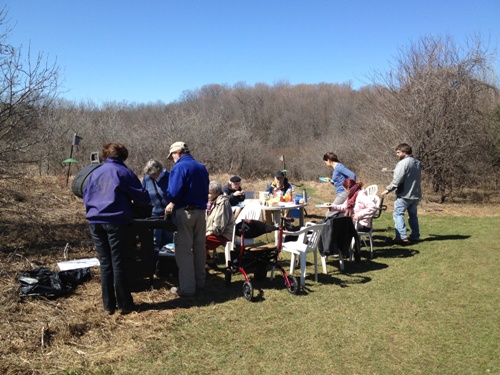|
|
THIS WEEK |
THIS SPRING |
2012 TOTAL |
SITE TOTAL |
|
# birds (and species) banded |
- |
- |
75 (10) |
35826 (108) |
|
# birds (and species) repeat |
- |
- |
14 (4) |
6427 (68) |
|
# birds (and species) return |
- |
- |
26 (6) |
987 (37) |
|
# species observed |
35 |
35 |
53 |
204 |
|
# net hours |
- |
- |
63.7 |
59162.9 |
|
# birds banded / 100 net hours |
- |
- |
117.7 |
60.6 |
|
|
Note: table does not include nocturnal banding (owls) |
Banders-in-charge: Simon Duval, Gay Gruner
Censusers: Jean Demers, Barbara Frei, Barbara MacDuff, Betsy Mcfarlane, Clémence Soulard, Victor Thamasson, Elise Titman, Rodger Titman
Maintenance day volunteers: Alex Bernal, Robert Boule, Jean Demers, Barbara Frei, Alison Hackney, Malcolm Johnson, Norsola Johnson, James Junda, Francine Marcoux, Betsy McFarlane, Chris Murphy, Mariner Palmer, Andrew Patterson, Clémence Soulard, Chick Taylor, Chris Taylor, Elise Titman, Rodger Titman, Victor Thomasson, Bruno Tremblay
Notes: After record high temperatures in March, a cold front came through for the first week of our Spring Migration Monitoring Program, pushing temperatures below normal for this time of year, and depositing a dusting of snow. However, the 35 species observed this week were close to average for the first week of the spring season. New species for the year were American Bittern (our earliest ever), Tree Swallow, Red-breasted Nuthatch, and Winter Wren.

The scene awaiting censusers on the first day of our 2012 spring season - a sharp contrast to the five straight days of temperatures in the 20s just a week earlier.
(Photo by Simon Duval)
|
This week’s
top 10
#
individuals banded |
mean # individuals observed daily |
- |
1. Canada Goose (298) |
- |
2. Red-winged Blackbird (42) |
- |
3. American Crow (16) |
- |
4. Black-capped Chickadee (15) |
- |
5. American Robin (13) |
- |
6. Ring-billed Gull (13) |
- |
7. Mallard (12) |
- |
8. Song Sparrow (11) |
- |
9. Wood Duck (9) |
- |
10. Blue Jay (8) |
|
As usual, the first three weeks of the spring program will be based primarily on the daily census, since weather is too often unsuitable for banding. Like in most previous years, Canada Goose was the most abundant species during week 1, with Red-winged Blackbird trailing by a substantial margin. American Crow, Black-capped Chickadee, American Robin, Ring-billed Gull, and Song Sparrow have also been in the top ten for week 1 each year. Reflecting the earlier than usual migration this year, Mallard and Wood Duck also made it into this week's list. in contrast to last year when Bohemian and Cedar Waxwing were both in the top ten, this year we saw just a single Cedar Waxwing all week.
|

As usual, early spring is an important time for site maintenance at MBO, especially ensuring that the trails are in good shape for the season. Tasks this year included replacing some of the boardwalks on the far side of Stoneycroft Pond, such as the one above. After a hard morning of work, the volunteer crew enjoyed a well-deserved barbecue, below - sincere thanks to all who helped!
(Photos by Simon Duval)

|




